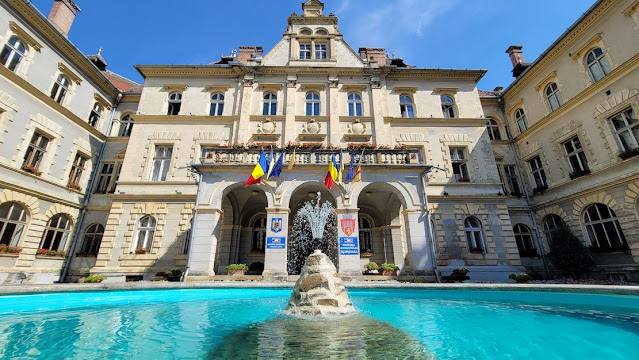This post sees us visit Sibiu and take a day trip to Sighisoara in heartland Transylvania in Romania.
Sibiu (Pop 147,245, Elev 420m, Founded 1191) is in the centre of Transylvania and known for its culture, history, gastronomy and diverse architecture. The Old Town is full of classical buildings with a central plaza that is huge and very reminiscent of the centre of Budapest Hungary. This is a pleasant place to visit with many towers, churches and the usual cafes and restaurants. The only downside is that many of the classical buildings and old houses are abandoned and simply falling down. The upside is that most of houses and buildings in Sibui have windows in their roof cavity that look like eyes – this is the meaning of Sibui.
Sibiu has the following Romanian claims to fame:
1) The first pharmacy, opened in 1494
2) The first mountain resort, opened in 1894
3) The first museum, opened in 1787
Enjoy classical and famous Sibiu...
The following day saw us travel on an organised private tour to the town of Sighisoara, the birthplace of Vlad The Impaler via Brateiu and Biertan. Our driver Sebastian picked us up at 0930 and we drove a total of 198km stopping at Brateiu first to talk with a Gypsy family who specialise in silver and copper ornaments. According to the main craftsman, Victor, his family have been making ornaments for many generations and it is now a struggle to keep his sons and daughters interested in continuing the tradition. Victor was even hired by Calvin Klein to make a series of silver rings, necklaces and bracelets for their jewellery or accessory line of products. Victor also explained that the Gypsy people, also know as Romani are slowly leaving their nomadic lives and settling into towns and building their own style of houses with flashy metallic rooves that look like ocean waves. Sebastian explained that these rooves are to “show off” one Gypsy to another. Victor was very frank and honest about his peoples saying that they are reluctant to integrate but he feels that they must do so. The Romani people, traditionally Țigani, are not offended by the word "Gypsy". According to the 2011 census, their number was 621,573 people or 3.3% of the total population, being the second-largest ethnic minority in Romania after Hungarians. The Romani people originate from northern India, mainly Rajasthan and Punjab. The linguistic evidence has indisputably shown that roots of Romani language lie in India: the language has grammatical characteristics of Indian languages and shares with them a big part of the basic lexicon, for example, body parts or daily routines. More exactly, Romani shares the basic lexicon with Hindi and Punjabi. It shares many phonetic features with Marwari, while its grammar is closest to Bengali. In February 2016, during the International Roma Conference, the Indian Minister of External Affairs stated that the people of the Roma community were children of India. The conference ended with a recommendation to the Government of India to recognize the Roma community spread across 30 countries as a part of the Indian diaspora. So interesting.
Biertan is one of the most important Saxon villages with fortified churches in Transylvania, having been on the list of UNESCO World Heritage Sites since 1993. The Biertan fortified church was the seat of the Lutheran Evangelical Bishop in Transylvania between 1572 and 1867. The Saxons are medieval peoples from the Mosel region of Germany who were invited by the Hungarian Empire in the 13th Century to occupy Transylvania to enable the Kingdom to expand. We can vouch for this having heard the locals speak German and the few tourists who were visiting with us were from Germany. The village and fortress were very impressive, colourful and well worth the visit.
Sighisoara (Pop 26,370, Elev 398m, Founded 1191) was even more impressive. Its Old Town is set on a hill and very comp act in size, full of colourful medieval buildings. There is a lower Old Town that dates back to the 18th Century and the rest of the town is surrounded by communist apartment blocks and many European companies who have set up here and caused the population to grow year on year. The entire Old Town is UNESCO protected and it is one of the easiest and quickest Old Towns to visit. The claim to fame of Sighisoara is the all-yellow house that claims to be the birth house of Vlad The Impaler or Dracula.
Enjoy the colours and sites of Transylvanian heartland…
And here are the EYES OF SIBIU !!!
To Victor and the Romani People (Gypsies):
Our last night in Sibui was a bit of a triumph for me having cooked two Romanian dishes with pork and veggies and zucchini balls, rice and veggies...























.jpg)
















No comments:
Post a Comment